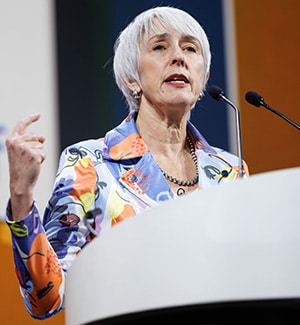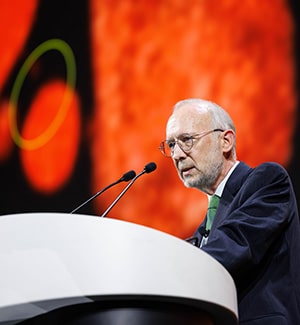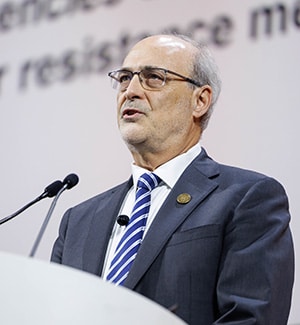Seventy percent of cancer-related deaths are from cancer types with no available screening options, underscoring the importance of detecting cancer early when it is more easily treated. The American Association for Cancer Research (AACR) Annual Meeting 2024, held April 5-10, kicked off its plenary program with a session on Discovery Science in Early Cancer Biology and Interception, which was chaired by Daniel De Carvalho, PhD, a professor at University of Toronto and researcher at the Princess Margaret Research Centre.
“[Early cancer detection] is where we can have the biggest impact from cancer research on clinical care,” De Carvalho said. He noted that novel early detection approaches will depend on understanding the molecular changes that occur as cells evolve from normal to precancer to cancer.
“We really need to understand early cancer biology and figure out ways to use this for cancer interception,” he said.
Just in time for the newly declared National Cancer Prevention and Early Detection Month, the session featured four presentations that explored the early changes underpinning cancer development and efforts to target these for cancer treatment.
What changes underlie clonal hematopoiesis?
In the first presentation, Margaret Goodell, PhD, FAACR, a professor at Baylor College of Medicine, discussed mechanisms that may drive clonal hematopoiesis, a state characterized by the outgrowth of genetically distinct populations of hematopoietic stem cells. Clonal hematopoiesis commonly occurs with aging and increases an individual’s risk for several blood cancers.
Understanding how clonal hematopoiesis develops is key to identifying novel approaches to prevent this premalignant condition from progressing to cancer, Goodell noted.

In three separate vignettes, she shared distinct mechanisms underlying clonal hematopoiesis, including commonly occurring mutations in PPM1D, the gene that encodes the p53 suppressor protein WIP1. Goodell showed that these mutations inactivated DNA repair and cell death mechanisms and made cells more likely to proliferate with unresolved DNA damage, particularly after exposure to chemotherapy drugs. Consistent with these preclinical findings, blood samples from patients who had received chemotherapy were enriched for PPM1D-mutated cells.
Chemotherapy exposure also increased the occurrence of mutations in the chromatin regulator SRCAP, the focus of Goodell’s second vignette. In contrast to PPM1D mutations, the commonly occurring SRCAP mutations increased DNA repair by upregulating the expression of DNA damage genes through histone alterations. Goodell noted that, although mutations in PPM1D and SRCAP had contrasting effects on DNA repair, they both provided survival advantages to hematopoietic stem cells—a phenomenon that might be explained by different environmental contexts.
Finally, Goodell discussed mutations in DNMT3A, which she described as “the most important tumor suppressor in the hematopoietic system.” She explained that hematopoietic stem cells with DNMT3A mutations exhibit enhanced self-renewal and suggested that this may be due to the mutants’ epigenetic impacts.
Goodell proposed that these mechanistic insights could lay the foundation for future cancer interception efforts. “In the long term,” she said, “we think there will be great opportunities for interventions if we can understand which mutations are particularly bad, in which contexts they arise, and how we can interfere with their functions.”
Why does breast cancer risk increase with age?

Most breast cancers are diagnosed in individuals 55 years of age or older, and research presented by Kornelia Polyak, MD, PhD, FAACR, a professor at Harvard Medical School and Dana-Farber Cancer Institute, shed light on the cancer-promoting changes that occur with aging.
Using rat models, Polyak and colleagues discovered that aging was associated with dysregulated proliferation of mammary epithelial cells (from which most breast cancers arise), altered gene expression, changes to the proportion of certain immune cells, modified tissue states, and the decline of various cellular functions.
Among the genes whose expression increased with aging was midkine (MDK), a growth factor that has been implicated in cancer and other diseases. Polyak shared data demonstrating that MDK was upregulated with aging in rat mammary tissue, as well as in plasma samples from older individuals and in human breast cancers. Additionally, individuals under the age of 55 whose normal breast tissue had higher levels of MDK were found to have a greater five-year risk of breast cancer, and young patients whose breast cancers had high levels of MDK had lower disease-free survival rates.
Further experimentation revealed that MDK may impact breast cancer development by activating the tumor-promoting PI3K signaling pathway, repressing tumor suppressive pathways, and enhancing metabolic activity—consequences mediated by SREBF1, a regulator of cell metabolism.

Don Cleveland, PhD, FAACR, a professor at the UC San Diego School of Medicine, shared mechanistic insights into chromothripsis (chromosome shattering) and its contributions to cancer development. He demonstrated that abnormal chromosomes accumulate in micronuclei, where they undergo chromothripsis through the action of the N4BP2 nuclease. Shattered chromosome fragments remain near one another due to tethering by the DNA repair protein TOPBP1, and this proximity facilitates aberrant ligation of the chromosome fragments into circular DNAs that amplify the expression of certain oncogenes and drive drug resistance.
Separately, he proposed that Epstein-Barr virus (EBV) may promote cancer through a similar tethering action as shattered chromosome fragments. He showed that the viral protein EBNA1 becomes tethered to an EBV-like DNA sequence in chromosome 11, which leads to chromosome breakage and the separation of the MLL gene from the rest of chromosome 11. The MLL-containing DNA fragment enters micronuclei and undergoes chromothripsis, re-ligation, and amplification of MLL. This, in turn, inactivates the DNA repair protein ATM and may promote the formation of cancer. (MLL is a negative regulator of ATM.)
Can genome instability be targeted for cancer treatment?

The accumulation of DNA damage can lead to cancer and, if left unresolved, trigger cell death. For this reason, many researchers are exploring inhibiting DNA repair as a potential approach to treat cancer. Michael Kastan, MD, PhD, FAACR, a professor at Duke University and executive director of Duke Cancer Institute, demonstrated the potential of an investigational chemical inhibitor of the DNA repair proteins ATM and DNA-PK to sensitize cells to radiation.
ATM and DNA-PK are signal transducers activated early in the response to DNA damage and regulate a multitude of downstream effector proteins that ultimately repair the damage or trigger cell death.
Kastan explained that ATM and DNA-PK are logical targets because 1) they are important regulators of DNA repair, 2) their activity is not essential to the survival of cells, and 3) cells that lack either protein remain sensitive to radiation.
He and colleagues identified XRD-0394, a novel dual inhibitor of ATM and DNA-PK, that could be delivered systemically. In preclinical models, XRD-0394 inhibited both proteins in a dose-dependent manner. Importantly, it led to cell death only in the presence of radiation, which allowed the drug to be delivered systemically without widespread toxicities.
Based on these preclinical data, Kastan and colleagues initiated a phase I clinical trial to evaluate the safety and pharmacokinetics of the drug in patients. The drug has not led to any dose-limiting toxicities thus far, and patient tumor samples indicate that the drug successfully inhibits ATM in patients. Kastan plans to explore combining XRD-0394 with various other therapies, such as immune checkpoint inhibitors, PARP inhibitors, and cytotoxic drugs.


